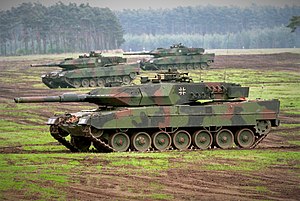ILMU PENGETAHUAN
| Main battle tank | |
|---|---|
 German Leopard 2A5 main battle tank. | |
| Type | Tank |
| Service history | |
| In service | 1946–present |
| Specifications | |
| | |
| Armor | Steel plate or composite armour. May be supplemented by explosive reactive armour plating. |
| Primary weapon | Tank gun |
| Suspension | Torsion bar or hydropneumatic. |
A battle tank was described in Treaty on Conventional Armed Forces in Europe as follows:
The term "battle tank" means a self-propelled armoured fighting vehicle, capable of heavy firepower, primarily of a high muzzle velocity direct fire main gun necessary to engage armoured and other targets, with high cross-country mobility, with a high level of self-protection, and which is not designed and equipped primarily to transport combat troops. Such armoured vehicles serve as the principal weapon system of ground-force tank and other armoured formations. Battle tanks are tracked armoured fighting vehicles which weigh at least 16.5 metric tonnes unladen weight and which are armed with a 360-degree traverse gun of at least 75 millimeters calibre. In addition, any wheeled armoured fighting vehicles entering into service which meet all the other criteria stated above shall also be deemed battle tanks.
History
Cold War
Medium tanks gradually evolved into the new concept of the MBT. This transition happened gradually in the 1960s[1], as it was realized that medium tanks could carry guns (such as the US 90 mm, Soviet 100 mm, and especially the British L7 105 mm) that could penetrate any practical level of armor at long range. The World War II concept of heavy tanks, armed with the most powerful guns and heaviest armor, became obsolete since they were just as vulnerable as other vehicles to the new medium tanks.[citation needed] Likewise, World War II had shown that lightly-armed, lightly-armored tanks were of little value in most roles. Even reconnaissance vehicles had shown a trend towards heavier weight and greater firepower during World War II; speed was not a substitute for armor and firepower.The Main Battle Tank thus took on the role the British had once called the 'Universal tank', exemplified by the Centurion, filling almost all battlefield roles. Typical Main Battle Tanks were as well armed as any other vehicle on the battlefield, highly mobile, and well armored. Yet they were cheap enough to be built in large numbers. The first American main battle tank was the M60[2], and the first Soviet main battle tank was the T-64[3].
[edit] Asymmetrical warfare

A German Leopard 2 in the PSO-version, prepared for asymmetrical warfare
Design
Overview
|
|
Countermeasures

The M1 Abrams has been modified to counter threats unique to asymmetric warfare
Other defensive developments focused on improving the strength of the armor itself; the most notable advancement coming from the British with the development of chobham armor in the 1970s. It was first employed on the American M1 Abrams and later the Challenger 1. Chobham armor uses a lattice of composite and ceramic materials along with metal alloys to defeat incoming threats, and proved highly effective in the conflicts in Iraq in the early 1990s and 2000s; surviving numerous impacts from rocket-propelled grenades with negligible damage.
[edit] Weapons suite

An M1 Abrams firing.

French Leclerc.
MBT main guns are generally between 90 and 130mm caliber and can fire both anti personnel rounds such as high explosive or high explosive fragmentation as well as dedicated anti armor rounds, usually both HEAT (highly explosive anti-tank), and some form of high velocity kinetic energy penetrator round, such as APFSDS (Armor-piercing fin stabilized discarding sabot) ammunition. The cannon serves a dual role, able to engage other armored targets such as tanks and fortifications, and soft targets such as light vehicles and infantry. It is fixed to the turret, along with the loading and fire mechanism. Modern tanks utilize a sophisticated fire-control system, including rangefinders, computerized fire control, and stabilizers, which are designed to keep the cannon stable and aimed even if the hull is turning or shaking, making it easier for the operators to fire on the move and/or against moving targets.
Usually, a MBT carries 30-50 rounds of ammunition for its main gun, usually split between HE, HEAT and kinetic energy penetrator rounds. Some MBT's may also carry smoke or white phosphorus rounds. Some MBTs are equipped with an auto-loader, such as the French Leclerc, or the Russian T-64, T-72, T-80 and T-90 and, for this reason,the crew is reduced to 3 members.
As secondary weapons, an MBT usually uses between one and four machine guns to engage infantry and light vehicles. Many MBTs mount one heavy caliber anti-aircraft machine gun (AAMG), usually of .50 caliber (like the Browning M2 or DShK), which can be used against helicopters and low flying aircraft. However, their effectiveness is limited in comparison to dedicated anti-aircraft artillery. The tank's machine guns are usually equipped with between 500 and 3000 rounds each.

An Arjun tank undergoing suspension testing

Hiya! I simply would like to give a huge thumbs up for the nice information
ReplyDeleteyou’ve gotten right here on this post. I will probably be coming again to your weblog for extra soon.
Here is my homepage - 禮品展
Good day! I simply wish to give an enormous thumbs up for the good data you
ReplyDeletehave got right here on this post. I will probably be coming again to your weblog for extra soon.
my page: travel website kayak finally files for ipo
Howdy! I simply want to give an enormous thumbs up for the
ReplyDeletegood data you will have right here on this post.
I will likely be coming again to your weblog for extra
soon.
Here is my weblog - ikea kitchen planner canada